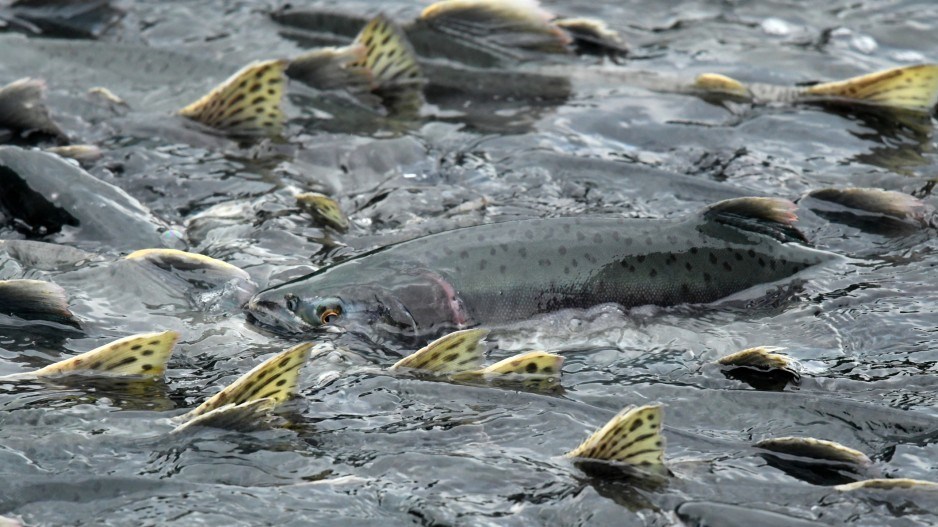The pre-season forecast for this year’s Fraser River sockeye returns -- 1.6 million – turns out to have been pretty much spot-on. The big surprise this year was pink salmon.
The pre-season forecast for Fraser River pink salmon was 6.1 million, but as of Wednesday, the tally was 10.3 million, according to the Pacific Salmon Commission.
To the scientists who have been studying Pacific salmon abundance, however, it’s not that surprising that sockeye continue to do so poorly when pink salmon are doing so well.
In a warming Pacific ocean, pink salmon appear to be winning the adaptation race and eating everything else out of house and home.
“We’re having high returns in all odd-numbered years throughout most of their range,” said Jim Irvine, a scientist at the Pacific Biological Station in Nanaimo and co-author of a new synthesis review published in
The new study, led by Greg Ruggerone, sheds some light on why pink salmon have been so successful, and also highlights the potential negative impacts their success may be having on other species.
“The evidence is consistent and strong that pink salmon can exert competitive dominance for common-pool prey resources shared by 4 forage fish species, all 5 species of Pacific salmon and steelhead trout, and 11 species of seabirds,” the paper concludes.
The paper points to a major ocean regime shift in 1977 that appears to have set the stage for a pink salmon population boom – an era that was also accompanied by the growth in fish hatcheries that began to augment wild stocks.
“The combination of the regime shift and the hatchery releases meant that, beginning in the late 1970s, the numbers of salmon began to increase in the ocean,” Irvine said.
“There’s actually more salmon out there in the Northern Pacific than pretty well anytime in our history,” Irvine said. “The reason that there’s more salmon out there now than there used to be is that about 40 per cent of the salmon out there are of hatchery origin. That is largely driven by chum salmon. It’s partly climate change, but it’s also hatcheries.”
There's not just more salmon in the Pacific, there are now even Pacific salmon in the Atlantic.
Specifically, there are pink salmon demonstrating just how adaptable they are by showing up in rivers and streams in the Atlantic, in places like Scotland and Newfoundland, as a consequence of Russia introducing pink salmon into rivers on the White Sea, which leads to the Barents Sea and Atlantic Ocean.
Pink salmon now account for 70 per cent of all Pacific salmon, the paper notes. Between 2005 and 2021, annual average abundance of adult pink salmon was 522 million fish, about 16 per cent of which originate from hatcheries. And in total, hatcheries now account for 40 per cent of the biomass of all salmon in the Pacific Ocean, the paper says.
Pink salmon are unique in that they live only two years, and there are two distinct and genetically isolated populations – odd and even year.
The odd-year pink salmon are the most successful, sometimes out-numbering even-year pinks in some regions by 25 to one. They appear to be adapting better to warming waters than other species and out-competing other species with similar diets. For pink salmon, zooplankton is a significant part of the fish’s diet.
“In aggregate, the evidence indicates that open-ocean marine carrying capacity in the northern North Pacific Ocean and Bering Sea can be mediated by top-down forcing by pink salmon and by ocean heating, and that large-scale hatchery production (~40% of the total adult and immature salmon biomass) likely has unintended consequences for wild salmon, including Chinook salmon, and many other marine species," the paper says.
More simply put, there’s only so much food in the ocean, and pink salmon and hatchery fish may be hoovering up so much of it that it leaves other species wanting.
This might at least partly explain why other species of salmon, like sockeye, have been in decline for some regions – like 小蓝视频 – while pink salmon continue to increase in abundance.
“Pink salmon are benefitting from warming more than other species,” Irvine said. “The odd-year brood line appears to be benefitting more than the even-year brood line, as the oceans warm up.
“If a sockeye is out there in an odd-numbered year, it’s going to be competing with the pink salmon because there’s more of them. In an even-numbered year, the competition is going to be less because there’s fewer pink salmon.”





